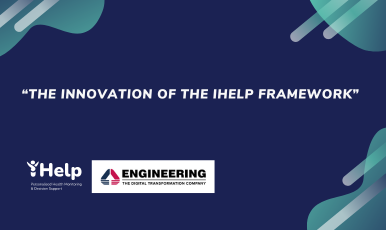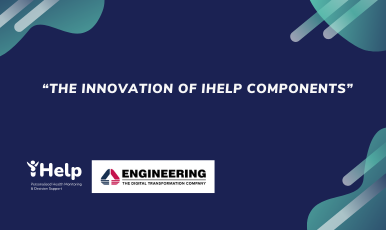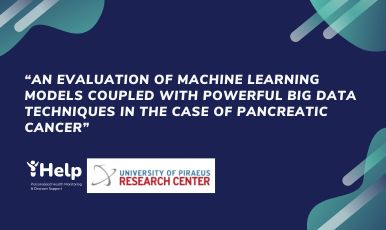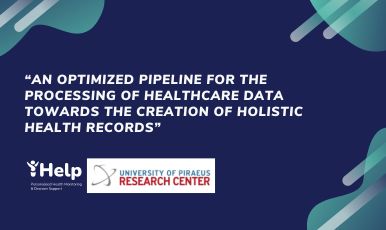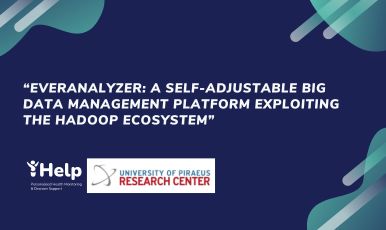Up to 30% of the world’s stored data is currently generated by healthcare systems. However, the healthcare sector is lagging in realising its potential: it is a “data-rich but information-poor” industry [OEC19]. Taking this into consideration, digital transformation can bring significant benefits to the healthcare sector and, in particular, cancer care is one of the major disease areas that will benefit from the better exploitation of clinical and real-world data using powerful tools such as Artificial Intelligence (‘AI’) and High-Performance Computing to improve e-health, decision support system, telemedicine, remote monitoring system, health data access and health data exchange.
The iHelp Framework and its components go exactly in this direction, enabling i) the collection, integration, and management of health-related data from various sources (medical records, lifestyle, behaviour data, and social media interactions) in a standardised structure called Holistic Health Records and ii) the analysis of these data using advance AI techniques to draw adaptive learning models iii) that are used to provide decision support, in the form of early risk predictions as well as personalised prevention & intervention measures, delivered through user-centric mobile and wearable applications.
The iHelp Framework is innovative according to several points of view, i.e. the technology innovation trends, the market forecast, the competitive advantage and the sustainability of the solution.
Technology Innovation trends
From a technological standpoint the iHelp Framework is innovative as interprets the most innovative technology trends in healthcare and incorporates most of the latest technologies for the sector [WHO24] [WEF23] [WEF24] [FOR24] [GAR24], in particular, the adoption of a more data-driven technologies to help diagnose diseases earlier, the use of Artificial Intelligence in detecting, diagnosing and treating disease, the implementation of Virtual Healthcare Assistants and chatbots helping clinicians by providing advice on treatments, diagnoses, and medications and patients by answering questions about their care. More in detail, firstly, the Data Ingestion pipeline represents all those components that enable a more effective use of health data and the extraction of value and knowledge out of them, not only in the context of the iHelp project, but also in the wider healthcare ecosystem. Indeed, given the challenge that in modern societies healthcare-related data are obtained from various sources and in divergent formats, this holistic mechanism provides the research and healthcare community with a wide range of innovative solutions for the cleaning, qualification, transformation, harmonization, and mapping of raw healthcare-related data to the HHR schema and with standardisation and quality procedures to facilitate data sharing and analytics. Secondly, the Data Analysis components implement the AI of the system to deliver a Personalized and Preventative Healthcare, byextracting meaningful information from integrated big datasets. Thirdly, the final user applications for the restitution of knowledge to the human actors of the system (i.e. HCP, Individual, Model Builder, and Policy Makers) go in the direction of Virtual Healthcare Assistants. Last, not least, the Big Data Platform is a relational distributed database with extended and innovative capabilities, the central and transversal component of the iHelp platform for data storage and management.

Figure 1: Data to Knowledge path.
Market forecasts
The market forecast for the iHelp Framework appears to be correspondingly promising. Indeed, Healthcare providers plan to prioritize investments in data and analytics, patient engagement, Interoperability technologies, Clinician productivity and usability tools, Virtual Care, EHR, AI applications and DSS for new or additional funding in 2024 [GAR23a].

Figure 2: Gartner Top Technology Investments for Healthcare Providers in 2024.
Competitive advantage
The competitive advantage of the iHelp Framework lies in its comprehensive and holistic approach to personalized healthcare through the introduction and integration of advanced techniques from the domains of AI, EHRs, ML and big data management. Moreover, its multidisciplinary approach and joint effort of experts from the healthcare domain reveal new pathways against the fight with pancreatic cancer.
One of the key strengths of the iHelp Framework is its use of advanced AI algorithms. These algorithms are designed to process and analyze health data in real-time, giving the healthcare providers critical insights that can lead to better decision-making.
Moreover, iHelp lays a strong emphasis on data privacy and security. The platform employs robust data governance and encryption techniques, as well as data anonymization processes to protect personal health information. This commitment to data privacy is crucial in building trust among users, who are more likely to participate and share their data when they are confident it will be handled securely.
Another significant advantage of the iHelp framework is its seamless integration with existing health systems. iHelp is designed to work with electronic health record (EHR) systems, wearable devices, and other health data sources, ensuring a comprehensive view of a patient’s health. Their efficient and effective integration, processing and analysis are key challenges in the context of the modern healthcare domain towards capturing all the health determinants of individuals and the provision of more precise, accurate, and personalized recommendations and care plans to them.
The user-centric design of the iHelp Framework further enhances its competitive advantage. The platform provides personalized health insights and recommendations, coupled with advanced explainability techniques and dashboards that increase user engagement and satisfaction, as well as the explainability and interpretability of the results from the healthcare professionals. Its user-friendly interface ensures accessibility for a broad audience, including individuals who may not be tech-savvy. The needs and preferences of users have been taken into consideration by following an extensive usability analysis and assessment of the platform.
An example of iHelp’s competitive advantage in practice is its ability to detect risk factors and stratify individuals into different levels of risk early before the onset of the disease, as it has been realized in the context of MUP pilot. The platform’s advanced AI can analyze hidden patterns in a patient’s health data that traditional methods might overlook, alerting healthcare professionals to potential issues before they become critical. This early detection capability is crucial for preventing serious health problems and underscores the value of iHelp’s advanced AI technology.
In conclusion, the combination of advanced AI capabilities, robust data protection, seamless integration, and a user-centric design, set iHelp as a leading solution in the healthcare technology market. The project offers significant benefits to the healthcare and research communities, as well as to the wider society and industry, highlighting its potentials towards the introduction of a substantial impact on the way healthcare is delivered and managed.
Sustainability
The sustainability of the iHelp Framework depends on the interest of partners in investing in the solution after the end of the project for its commercialisation. As reported more deeply in D8.7, a “lean” joint exploitation strategy is defined and has been agreed upon by the project partners. This joint exploitation is based on partnerships of iHelp partners (and if needed, organisations outside iHelp) to address specific business opportunities using the outcomes of iHelp. Thus, technical and clinical partners can team-up as they prefer to target business opportunities, reusing any part of the iHelp Framework (or its entirety), taking advantage of the perpetual discounted prices of partners not in the current team, under the condition that these will be used for the iHelp cancer programs only.
Results
The results of our analysis, matching all the selection criteria, are that the iHelp Framework appears overall promising to play a key role in the healthcare market with innovative and impactful approach for the healthcare industry.
Indeed, it is very innovative from a technological point of view because it interprets the most innovative technology trends in healthcare and incorporates the latest technologies for the sector. The market forecast looks promising accordingly, since most healthcare providers’ investments, over the next few years, will be in the technologies already included and in line with the approaches already implemented by the iHelp Framework. The competitive advantage can be seen in several aspects, among which the comprehensive and holistic approach to a personalized healthcare, and the sustainability will be aspired through a joint exploitation strategy between the partners in response to specific business opportunities.
[OEC19] OECD, Health in the 21st Century: Putting Data to Work for Stronger Health Systems, OECD Health Policy Studies, OECD Publishing, Paris, 2019.
[WHO24] World Health Organization, Digital Health https://www.who.int/health-topics/digital-health#tab=tab_1
[WEF23] World Economic Forum, 5 innovations that are revolutionizing global healthcare, Feb 22, 2023 https://www.weforum.org/agenda/2023/02/health-future-innovation-technology/
[WEF24] World Economic Forum, Resilient, equitable and sustainable: How to deliver healthcare that maximizes the benefits of scientific innovation, Jan 10, 2024 https://www.weforum.org/agenda/2024/01/how-to-deliver-healthcare-that-maximizes-benefits-of-scientific-innovation/
[FOR24] Forbes, The 10 Biggest Trends Revolutionizing Healthcare in 2024, https://www.forbes.com/sites/bernardmarr/2023/10/03/the-10-biggest-trends-revolutionizing-healthcare-in-2024/
[GAR24] Gartner, 2024 Healthcare Provider Business Driver: Health Technology Innovation, 30 January 2024
[GAR23a] Gartner, Healthcare Provider CIOs’ Planned 2024 Technology Spend, 7 December 2023

